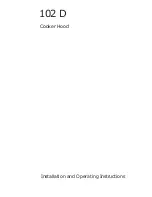
5
INSTALLATION REQUIREMENTS
TOOLS AND PARTS
Gather the required tools and parts before starting installation. Read and follow the
instructions provided with any tools listed here.
TOOLS NEEDED
•
Level
•
Drill with 1¼" and ¹⁄₈" Drill Bits
•
Pencil
•
Wire Stripper or Utility Knife
•
Tape Measure or Ruler
•
Pliers
•
Caulking Gun
•
Caulking Compound (weatherproof)
•
Vent Clamps
•
Jigsaw or Keyhole Saw
•
Flat-blade Screwdriver
•
Metal Snips
•
Phillips Screwdriver
PARTS NEEDED
•
6" dia. round metal duct - length required is determined by ceiling height.
PARTS SUPPLIED
Remove parts from packages. Check that all parts are included.
•
Vent Hood Assembly (including a
metal grease filter and a charcoal
filter)
•
120 V Power Cord (with 3 prong plug)
•
Two-piece Vent Structure (upper and
lower)
•
Two-piece Vent Cover (upper and
lower)
•
Phillips Pan-head
Screws (8)
•
Small Phillips Pan-head
Screws (3)
•
Phillips Self-drilling
Screws (16)
•
Phillips Countersunk-
head Screws (4)
LOCATION REQUIREMENTS
IMPORTANT: Observe all governing codes and ordinances.
Have a qualified technician install the range hood. It is the installer’s responsibility to
comply with installation clearances specified on the model/serial rating plate. The
model/serial rating plate is located behind the left filter on the rear wall of the vent
hood.
Canopy hood location should be away from strong draft areas, such as windows,
doors and strong heating vents.
Grounded electrical outlet is required. See “Electrical Requirements” section.








































